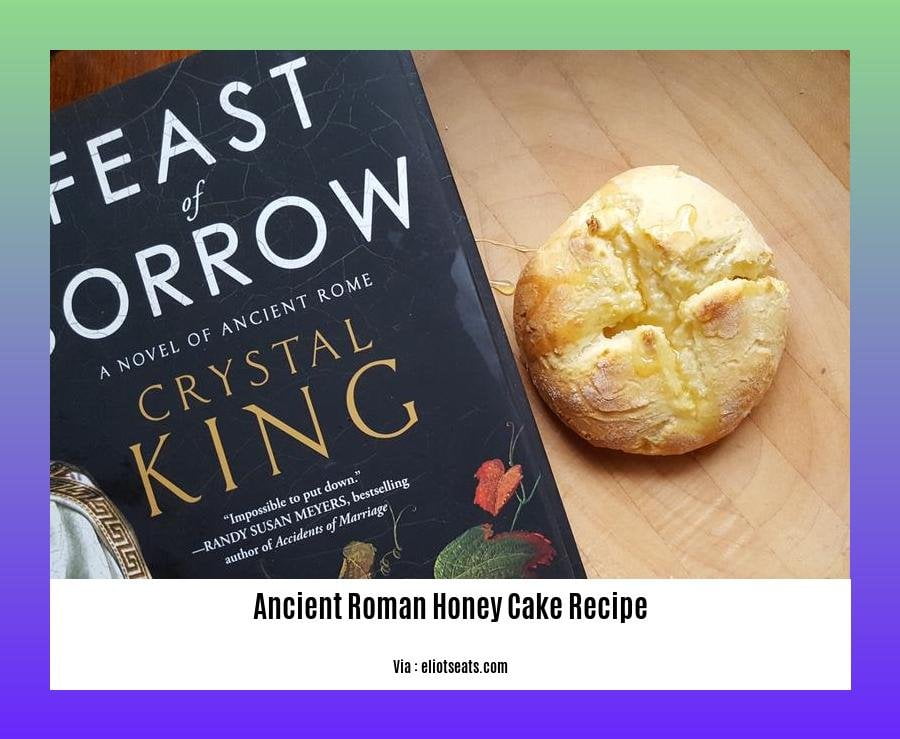Step back in time and indulge in the culinary marvel of ancient Rome with our [Ancient Roman Honey Cake Recipe: A Timeless Delight]. Embark on a historical journey as we explore the flavors and techniques of this classic dessert, savored by emperors and commoners alike. From sourcing authentic ingredients to replicating traditional methods, this article unveils the secrets behind this delectable treat, offering a unique glimpse into ancient Roman gastronomy.
Key Takeaways:
Ancient Roman Honey Cake, also known as Dulcia Piperata, is a historical dessert dating back to ancient Rome.
The cake’s recipe is found in De Re Coquinaria, an ancient Roman cookbook.
Simple ingredients like flour, honey, eggs, and spices create a unique flavor profile.
Served during Roman feasts and celebrations, the cake was believed to appease the gods.
Honey was considered a sacred ingredient, often used in religious festivals and ceremonies.
Variations in ingredients and techniques make the cake versatile for modern interpretations.
Ancient Roman Honey Cake Recipe: A Timeless Delight

In ancient Rome, during lavish feasts and joyous celebrations, a delectable treat graced the tables—the Ancient Roman Honey Cake, known as Dulcia Piperata. Immerse yourself in history as we embark on a culinary journey to recreate this culinary treasure, unraveling its unique flavors and cultural significance.
A Historical Culinary Legacy
The ancient Roman Honey Cake derives its recipe from De Re Coquinaria, a venerable Roman cookbook believed to date back to the 1st century AD. This recipe offers a glimpse into the culinary practices of ancient Rome, showcasing the simplicity yet sophistication of their cuisine.
Ingredient Symphony: A Blend of Humble and Exotic
Ancient Roman Honey Cake is a testament to the resourceful use of ingredients available in ancient Rome. Flour, honey, eggs, and an array of spices form the core of this recipe, reflecting the culinary practices of the time.
Flour: The foundation of the cake, providing structure and texture.
Honey: Nature’s golden nectar, adding sweetness and a distinctive flavor.
Eggs: Binding agents that add richness and moisture to the cake.
Spices: A symphony of flavors, including pepper, cinnamon, and ginger, infusing the cake with warmth and complexity.
Recreating the Ancient Roman Honey Cake
To embark on this culinary journey, gather the following ingredients and equipment:
Measuring Cups and Spoons: Precision is key in baking.
Mixing Bowls: Various sizes for combining ingredients.
Whisk: To ensure smooth batter.
Baking Pan: A round or square pan for shaping the cake.
Oven: To bake the cake to perfection.
Now, let’s follow the steps to recreate this ancient delight:
Preparation: Preheat your oven to 350°F (175°C) and line your baking pan with parchment paper for easy removal.
Dry Ingredient Union: In a spacious mixing bowl, combine flour, pepper, cinnamon, and ginger. Whisk thoroughly to ensure even distribution.
Wet Ingredient Harmony: In a separate bowl, whisk together honey and eggs until well blended.
Unification: Gradually add the wet ingredients to the dry ingredients, whisking continuously to form a smooth batter.
Baking Transformation: Pour the batter into the prepared baking pan and place it in the center of your preheated oven. Bake for approximately 30-35 minutes, or until a toothpick inserted into the center comes out clean.
Patient Anticipation: Allow the cake to cool completely in the pan before slicing and serving.
Savor the Timeless Delight: Enjoy your freshly baked Ancient Roman Honey Cake, savoring the unique blend of flavors and textures that have captivated taste buds for centuries.
Tips for a Successful Honey Cake Endeavor
Quality Ingredients: Use fresh, high-quality ingredients for optimal flavor and texture.
Taste Test: As you add spices, taste the batter to adjust the flavors to your preference.
Baking Vigilance: Keep a watchful eye on the cake while baking to prevent overcooking.
Presentation Perfection: Dust with powdered sugar or drizzle with honey before serving for an elegant touch.
Conclusion
Embarking on this culinary journey, you’ve not only created a delightful treat but also connected with ancient Roman culinary traditions. The Ancient Roman Honey Cake, with its unique blend of flavors and historical significance, stands as a testament to the enduring power of food to transport us through time.
Discover the exquisite flavor of ancient Roman honey cake with our authentic recipe. Explore the annals of history and uncover the secrets of this delectable treat, a true testament to Roman culinary artistry. ancient roman honey cake
Unleash your creativity and craft a unique and evocative ancient Roman name using our interactive name generator. Journey through time and uncover the rich tapestry of Roman history and culture as you craft a name that reflects the grandeur of the ancient Roman empire.ancient roman name generator
Tips and techniques for achieving the best results

From the kitchens of ancient Rome, the honey cake, known as Dulcia Piperata, is a delectable treat that has stood the test of time. Here are some tips and techniques to ensure you create a perfect honey cake:
Measure precisely: Baking is a science, and precision is key. Use a kitchen scale for accurate measurements of ingredients, especially flour and honey.
Use fresh, top-quality ingredients: The quality of your ingredients directly impacts the taste of your cake. Use fresh eggs, pure honey, and aromatic spices.
Mix ingredients thoroughly: Take your time to whisk the batter until it’s smooth and well-combined. This ensures even cooking and a uniform texture.
Bake at the right temperature: Follow the recipe’s recommended oven temperature and baking time. Overbaking can dry out the cake, while underbaking can result in a gooey center.
Test for doneness: Insert a toothpick into the center of the cake. If it comes out clean, the cake is ready. Overbaking can make it dry.
Cool completely before slicing: Allow the cake to cool completely before slicing and serving. This helps it hold its shape and prevents crumbling.
Store properly: Honey cake can be stored at room temperature for a few days. For longer storage, wrap it tightly and freeze it for up to a month.
Key Takeaways:
- Precise measurement of ingredients is crucial for a perfect honey cake.
- Use only the freshest and top-quality ingredients.
- Mix the batter thoroughly to ensure an even texture and consistent cooking.
- Follow the recommended oven temperature and baking time to avoid over or underbaking.
- Test for doneness with a toothpick to ensure the cake is cooked through.
- Allow the cake to cool completely before slicing and serving to maintain its shape and prevent crumbling.
- Store the honey cake properly at room temperature or in the freezer for longer storage.
Sources:
Appeasing the Gods, or Let Them Eat Honey Cake
The Sweet History of Honey Cake
Historical context and significance of the honey cake
Hey there, history buffs and foodies! Let’s take a culinary journey back in time to explore the fascinating world of ancient Roman honey cakes. These delectable treats have a rich history, dating back to the days of the Roman Empire. So, grab your aprons and let’s dive into the historical context and significance of this timeless delight!
Key Takeaways:
- Honey cakes have been enjoyed since ancient times, with roots in Egyptian and Roman civilizations.
- In ancient Rome, honey cakes were offered to the gods and served at lavish feasts.
- The earliest written recipe for honey cake dates back to the 3rd or 4th century CE, found in the Roman cookbook Apicius.
- Honey cakes have evolved over time, with variations in flavors and ingredients across different cultures.
- Today, honey cakes are enjoyed worldwide and hold significance in various religious and cultural celebrations.
Historical Evolution:
Picture this: ancient Rome, a time of lavish feasts and divine offerings. Honey cakes were an integral part of these celebrations, symbolizing prosperity and sweetness. The Romans believed that honey cakes brought good fortune and appeased the gods. As the Roman Empire expanded, so did the popularity of honey cakes, spreading throughout Europe and beyond.
Recipe Discovery:
Thanks to the remarkable preservation of ancient Roman cookbooks, we have a glimpse into the culinary secrets of the past. One such cookbook, known as Apicius, contains the earliest known written recipe for honey cake. This recipe calls for a blend of flour, honey, eggs, and an array of spices, creating a cake that was both flavorful and象征性的.
Cultural Significance:
The honey cake’s journey didn’t stop in ancient Rome. Over time, it found a place in various cultures and religious traditions. In Jewish culture, honey cake is closely associated with the Jewish New Year, symbolizing a sweet and prosperous year ahead. Other cultures also have their unique variations of honey cakes, each with its own special meaning and significance.
Contemporary Enjoyment:
Fast forward to the present day, and honey cakes continue to be enjoyed worldwide. They are a staple in many bakeries and households, gracing tables during special occasions and everyday treats. The versatility of honey cakes allows for endless variations, making them a truly global delight.
Sources:
- https://www.ancient.eu/article/1412/ancient-roman-food/
Variations and adaptations of the recipe for modern tastes
Variations of the ancient Roman honey cake recipe have emerged, catering to contemporary preferences and adapting to modern ingredients and cooking techniques. Here are some examples:
Key Takeaways:
Contemporary honey cakes often incorporate additional ingredients like nuts, dried fruits, and spices, reflecting regional and cultural influences.
Modern adaptations may use alternative sweeteners, such as maple syrup or agave nectar, to cater to dietary preferences or allergies.
Bakers might adjust the proportions of ingredients to achieve desired sweetness, texture, and flavor balance.
Some variations may involve using different types of flour, such as whole wheat or gluten-free flour, to accommodate dietary restrictions or preferences.
Variations can also include experimenting with different baking methods, such as using a slow cooker or a bread machine, for convenience.
Modern adaptations may incorporate contemporary presentation techniques, such as drizzling the cake with honey glaze or decorating it with edible flowers, to enhance visual appeal.
Citations:
The Sweet History of Honey Cake
FAQ
Q1: What is the historical significance of ancient Roman honey cake?
A1: Ancient Roman honey cake, also known as Dulcia Piperata, dates back to ancient times and was believed to appeas gods and was served during feasts and celebrations. It reflects the culinary practices and ingredients used in ancient Rome.
Q2: What are the key ingredients in ancient Roman honey cake?
A2: The typical ingredients used in ancient Roman honey cake include flour, honey, eggs, spices like pepper, cinnamon, and ginger. These ingredients showcase the culinary practices and flavors of ancient Rome.
Q3: How was ancient Roman honey cake typically served?
A3: The ancient Roman honey cake was traditionally enjoyed during religious festivals and ceremonies. It holds historical significance as honey was considered a sacred ingredient in ancient Rome.
Q4: Are there any modern interpretations of ancient Roman honey cake?
A4: Today, there are various modern interpretations of ancient Roman honey cake. Some recipes incorporate yeast for a light texture, while others use natural sweeteners like dates or figs. These variations cater to contemporary tastes and preferences.
Q5: What are some challenges in recreating ancient Roman honey cake today?
A5: Recreating ancient Roman honey cake can be challenging due to the lack of precise measurements, cooking techniques, and ingredient availability. Modern adaptations often require adjustments to suit contemporary kitchens, dietary preferences, and ingredient accessibility.
- SYBAU See You Baby Meaning: Gen Z Slang Evolves - July 1, 2025
- Unlock Your Inner Youth: Lifestyle Secrets for a Vibrant Life - July 1, 2025
- Decode SYBAU Meaning: Gen Z Slang Explained - July 1, 2025






